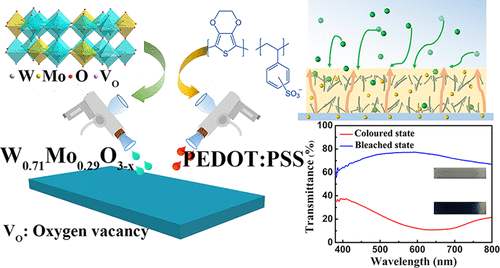当前位置:
X-MOL 学术
›
ACS Appl. Mater. Interfaces
›
论文详情
Our official English website, www.x-mol.net, welcomes your feedback! (Note: you will need to create a separate account there.)
Solution-Processed Interfacial PEDOT:PSS Assembly into Porous Tungsten Molybdenum Oxide Nanocomposite Films for Electrochromic Applications
ACS Applied Materials & Interfaces ( IF 9.5 ) Pub Date : 2018-03-06 00:00:00 , DOI: 10.1021/acsami.7b18310 Haizeng Li 1 , Liam McRae 1 , Abdulhakem Y. Elezzabi 1
ACS Applied Materials & Interfaces ( IF 9.5 ) Pub Date : 2018-03-06 00:00:00 , DOI: 10.1021/acsami.7b18310 Haizeng Li 1 , Liam McRae 1 , Abdulhakem Y. Elezzabi 1
Affiliation

|
Electrochromic devices (ECDs) have received increased attention for applications including optoelectronics, smart windows, and low-emission displays. However, it has been recognized that the ECDs with transition-metal oxide (TMO) electrodes possess a high charge transport barrier because of their poor electrical conductivity, which limits their electrochromic performance. In this work, we addressed this limitation by utilizing a conjugated polymer to fabricate an organic–inorganic nanocomposite film that decreases the charge transport barrier of typical TMO electrodes. Using a conventional spray-layer-by-layer (spray-LbL) deposition technique, we demonstrate an electrochromic film composed of porous layers of tungsten molybdenum oxide (W0.71Mo0.29O3) nanorods permeated with an interconnected conductive layer of poly(3,4-ethylenedioxythiophene) polystyrene sulfonate (PEDOT:PSS). The introduction of PEDOT:PSS is shown to significantly reduce the charge transport barrier, allowing the nanocomposite W0.71Mo0.29O3/PEDOT:PSS electrode to exhibit significantly improved electrochromic switching kinetics compared with the deposited W0.71Mo0.29O3 films. Furthermore, the optical contrast of the nanocomposite electrode was observed to be superior to both pure PEDOT:PSS and W0.71Mo0.29O3 electrodes, with a performance that exceeded the linearly predicted contrast of combining the pure films by 23%. The enhanced performance of the PEDOT:PSS-intercalated porous W0.71Mo0.29O3 nanocomposite electrodes and the facile synthesis through a spray-LbL method demonstrate a viable strategy for preparing fast assembling high-performance nanocomposite electrodes for a wide variety of electrochemical devices.
中文翻译:

溶液处理的界面PEDOT:PSS组装成多孔的氧化钼钼纳米复合薄膜,用于电致变色应用
电致变色设备(ECD)在包括光电,智能窗户和低排放显示器在内的应用中受到越来越多的关注。但是,已经认识到,具有过渡金属氧化物(TMO)电极的ECD由于其较差的电导率而具有较高的电荷传输势垒,这限制了它们的电致变色性能。在这项工作中,我们通过利用共轭聚合物制造有机-无机纳米复合膜来解决这一局限,该膜降低了典型TMO电极的电荷传输势垒。使用传统的逐层喷涂(spray-LbL)沉积技术,我们演示了由氧化钼钨(W 0.71 Mo 0.29 O 3)的多孔层组成的电致变色膜)纳米棒,该纳米棒上有一个由聚(3,4-乙撑二氧噻吩)聚苯乙烯磺酸盐(PEDOT:PSS)互连的导电层。PEDOT:PSS的引入显示出显着降低电荷传输势垒,与沉积的W 0.71 Mo 0.29 O 3膜相比,纳米复合材料W 0.71 Mo 0.29 O 3 / PEDOT:PSS电极表现出显着改善的电致变色动力学。此外,观察到纳米复合电极的光学对比度优于纯PEDOT:PSS和W 0.71 Mo 0.29 O 3。电极的性能比纯膜结合的线性预测对比度超出了23%。PEDOT:PSS插层的多孔W 0.71 Mo 0.29 O 3纳米复合电极的增强性能以及通过喷雾LbL方法的简便合成证明了为各种电化学装置制备快速组装的高性能纳米复合电极的可行策略。
更新日期:2018-03-06
中文翻译:

溶液处理的界面PEDOT:PSS组装成多孔的氧化钼钼纳米复合薄膜,用于电致变色应用
电致变色设备(ECD)在包括光电,智能窗户和低排放显示器在内的应用中受到越来越多的关注。但是,已经认识到,具有过渡金属氧化物(TMO)电极的ECD由于其较差的电导率而具有较高的电荷传输势垒,这限制了它们的电致变色性能。在这项工作中,我们通过利用共轭聚合物制造有机-无机纳米复合膜来解决这一局限,该膜降低了典型TMO电极的电荷传输势垒。使用传统的逐层喷涂(spray-LbL)沉积技术,我们演示了由氧化钼钨(W 0.71 Mo 0.29 O 3)的多孔层组成的电致变色膜)纳米棒,该纳米棒上有一个由聚(3,4-乙撑二氧噻吩)聚苯乙烯磺酸盐(PEDOT:PSS)互连的导电层。PEDOT:PSS的引入显示出显着降低电荷传输势垒,与沉积的W 0.71 Mo 0.29 O 3膜相比,纳米复合材料W 0.71 Mo 0.29 O 3 / PEDOT:PSS电极表现出显着改善的电致变色动力学。此外,观察到纳米复合电极的光学对比度优于纯PEDOT:PSS和W 0.71 Mo 0.29 O 3。电极的性能比纯膜结合的线性预测对比度超出了23%。PEDOT:PSS插层的多孔W 0.71 Mo 0.29 O 3纳米复合电极的增强性能以及通过喷雾LbL方法的简便合成证明了为各种电化学装置制备快速组装的高性能纳米复合电极的可行策略。



























 京公网安备 11010802027423号
京公网安备 11010802027423号